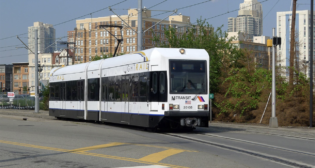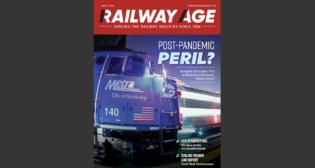
Amtrak Releases FY2021 Results
Written by Marybeth Luczak, Executive Editor
The Cummins-powered ALC-42 from Siemens will soon be the standard-bearer of the Amtrak long-distance locomotive fleet.
For its 50th anniversary fiscal year (Oct. 2020-Sept. 2021), Amtrak provided 12.2 million passenger trips, representing a growth of 4 million over the 2020 rate and a 42% rise over its FY21 goal, the railroad reported on Dec. 13.
“Business is now at about 70% of pre-COVID levels, up from 25% at this time in FY20, and based on the current forecast, ridership and revenue is expected to improve to about 80% of pre-COVID levels by the end of FY22,” according to Amtrak.
Among the railroad’s preliminary results for FY21:
• Adjusted operating earnings were ($1.08 billion) and $400 million “ahead of plan due to strong ridership gains driven by new approaches to marketing and pricing that helped attract new riders,” Amtrak reported.

• $2.2 billion in capital spending was advanced. This covered the Hudson Tunnel Project property acquisition, which followed federal environmental project approvals and permits. Amtrak purchased property at 260 12th Avenue in Manhattan, the site of the construction shaft and permanent ventilation plant for the tunnel. Amtrak’s FY21 capital spending also included new multi-powered trainsets. In July, Amtrak awarded Siemens Mobility $3.4 billion in contracts to design, manufacture, and provide technical support services and maintenance for 83 trainsets of two power configurations, with options for up to 130 additional trainsets. Amtrak’s total investment—with a long-term parts supply and service agreement, facility modifications and upgrades, and contingencies—is $7.3 billion. Deliveries are slated to commence in 2024. (Amtrak also continued to advance production of the new Acela trainsets for the Northeast Corridor and the ALC-42 diesel-electric locomotives that will power the National Network.)
• Amtrak’s COVID-19 vaccine mandate for employees has resulted in about 97% having at least one vaccination dose, the railroad reported, “excluding employees who are on leave of absence or have an approved accommodation.” (For more, read: “Amtrak: Updated Vaccine Policy Allows Employee Testing, Eliminates Service Impacts.”)
“Our customers trust Amtrak’s commitment to safety and are responding positively to the investments and improvements we are making,” Amtrak CEO Bill Flynn said. “We will continue to prioritize offering a modern, safe and reliable customer experience and preparing for what should be a monumental fiscal year 2022.”

“Our 50th year as a company is certainly a milestone, and we launched several hallmark initiatives as we embark on a new era for passenger rail,” Amtrak Board Chair Tony Coscia said. “The Bipartisan Infrastructure Law enacted by the Biden Administration and Congress is a historic investment that will benefit customers and communities and prove that Amtrak is an important part of a larger solution to help America tackle the climate crisis, create economic opportunity and expand mobility.”
Other FY21 highlights:
• Amtrak Connects Us: Amtrak launched its “vision to advance the development of more frequent, reliable and sustainable intercity passenger rail service to over 160 more communities and 20 million more passengers annually by 2035.” The economic benefit, Amtrak said, could reach $8 billion annually by 2035, with an additional $195 billion in economic activity generated by additional capital investment between 2021 and 2035.

• New Service: Amtrak submitted an application under 49 U.S.C. § 24308(e), seeking an Surface Transportation Board order requiring host freight railroads CSX and NS to allow intercity passenger trains to operate over their lines between New Orleans and Mobile. (Read Railway Age coverage.) Amtrak also executed a $944 million agreement with Virginia to more than double the number of state-sponsored services in the Commonwealth over the next 10 years.
• Stations: Amtrak opened the Moynihan Train Hall, located inside the Farley Post Office building, in New York City. At New York Penn Station, it installed new wayfinding signage and an Ultraviolet Germicidal Irradiation System in one of the HVAC units in the Amtrak concourse; refreshed platforms; and completed the second and final phase of the Ticketed Waiting Area refresh in conjunction with NJ Transit. Amtrak also achieved financial close with Plenary Infrastructure Philadelphia (PIP) on a lease and development agreement for the restoration and renovation of the William H. Gray III 30th Street Station in Philadelphia. Additionally, the railroad announced, with the state of Vermont, the town of Brattleboro and NECR Railroad, a proposal for a new Americans with Disabilities Act (ADA)-compliant Brattleboro Station.

• Infrastructure: Amtrak and the Maryland Department of Transportation released new plans to replace the 148-year-old Baltimore & Potomac (B&P) Tunnel on the Northeast Corridor in the next 10 years at a cost of $4 billion. Amtrak also broke ground on Baltimore Penn Station redevelopment and platform improvements. Also in 2021, the Portal North Bridge Project secured a Full Funding Grant Agreement from the Federal Transit Administration, and NJ Transit approved the award of the construction contract.
• Upgrades: Amtrak debuted a refreshed food and beverage menu “along with top-quality dining experience for customers riding in First Class onboard Acela trains,” it said. The railroad also restored traditional dining service on the California Zephyr, Coast Starlight, Empire Builder, Southwest Chief, Sunset Limited and Texas Eagle following pandemic-related suspension of the service. In addition, Amtrak unveiled refreshed railcar interiors and other onboard improvements for riders, as part of a three-year, $28 million initiative to modernize more than 450 long-distance service cars.

Climate resilience: Amtrak reported that it developed and is implementing a Climate Resiliency Strategic plan, including a climate vulnerability assessment for the Northeast Corridor that “will identify assets and segments of the electrified rail network where heat, sea level rise, wind, and heavy precipitation events could notably affect the Amtrak business by mid-century and 2100.” Amtrak said it also created a resilience strategic plan “to integrate climate considerations into business practices and planning efforts.”
Accessibility: Progressing work at 95 stations, Amtrak said it expended more than $93 million on ADA station projects. This includes five assessments, 28 station designs, 20 station construction projects, 16 Passenger Information Display System (PIDS) designs and three PIDS deployments. Amtrak now has 155 stations fully or partially ADA-compliant. “Aiming to expand accessibility to passengers across all fleets, Amtrak continued efforts on the ADA Fleet Compliance project, which comprises 12 separate rail car modifications, such as installing onboard wheelchairs for quick evacuation, applying non-skid vestibule floor coating, and modifying the first floor of bi-level Long Distance cars to create an accessible path of travel to ADA compliant restrooms,” the railroad reported.
Technology: Amtrak began offering new digital payment options on its mobile app and Amtrak.com. It also introduced app improvements, including the expansion of push notification capabilities for gate and track information, new notification offerings featuring tips and information during service disruptions or cancellations, a text service to speak directly to an agent (also available on Amtrak.com), and the ability to cancel (initiate a refund) or modify a trip. Amtrak has also debuted digital timetables.
State-Supported Services: Amtrak launched expanded rail service from Richmond, Va., to the Northeast Corridor.

Talent/People: Amtrak reported that it extended 1,744 employment offers and scaled up recruitment, hiring and retention efforts. In addition, it supported company-wide COVID-19 response and remote working efforts, including developing a process for accommodation requests. Amtrak also recalled more than 1,200 furloughed employees after receiving COVID-19 relief funding.



